|
|
NETWORK
SOUTHEAST
(1986 - 1994)
|
|
| |
FROM SOUTHERN REGION TO
SECTORISATION
Since
nationalisation and the forming of British Rail, the
system had been operated by regions loosely reflecting
the previous "big four" railway companies. The
Epsom Downs branch had thus passed from the former
Southern Railway (SR) to BR's Southern Region (S.R.).
|
| |
| This still
essentially geographical focus was changed to a
more business oriented perspective with the
so-called sectorisation of BR in 1982, creating
separate divisions for the main BR traffic
segments such as commuter services, long distance
intercity services, parcels and freight.
The operation of passenger
services in the South-East of England was
assigned and handed over to the London &
South Eastern sector.
No doubt commuters from
the Epsom Downs branch had already noticed the
somewhat unusual L&SE livery of chocolate,
orange and grey which was quickly nicknamed
jaffa
cake - and never to be seen on the Epsom
Downs line as the immediate changes which
sectorisation brought about remained extremely
subtle on the branch as BR blue and grey liveried
EMUs remained in charge of all services.
|
|
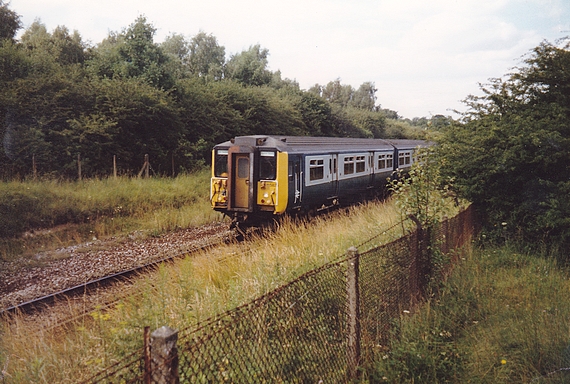
CL 455
crossing Banstead Downs in July 1987
|
|
| |
| Change did finally come,
however, when the L&SE Sector was relaunched on June 10th 1986 at Waterloo station under a new chairman
(Chris Green) and a new name: Network SouthEast (NSE). 
Unlike BR Provincial (which
operated interregional and other subsidised services),
NSE was expected to cover most of its operating costs
from the revenues it generated. Whilst it did did not own
(or maintain) its infrastructure, NSE had ownership of
its rolling stock and equipment, which it painted in its
own bright and multicolour livery - nicknamed
"toothpaste" by some, it immediately became a
trademark token of the Sector .
|
| |
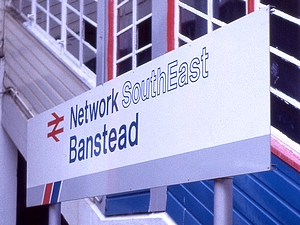
Banstead
station sign in December 1990
|
|
NSE also
exercised control over almost all the core
passenger carrying functions, set its own goals
and service standards (in consultation with BR),
created its own management structure, and defined
its policy with regard to scheduling, marketing,
infrastructure enhancements, and rolling stock
specifications (Lawrence, 1994). At the end of the day, it was all about
accountability and modernisation, and the man up
front - managing director Chris Green - knew that
communication was a key element in this game from
his previous glory days with ScotRail, and NSE
brought an entirely new visual image to most of
the railways of the South East almost over night.
The striking new livery made sure that
each and every passenger knew straight away that
something was happening here; however, it was all
about far more than just colourful trains.
|
|
| |
| In the first four
years of its existence, passenger income on NSE rose by
nearly 20%, government support had fallen by 50%, and the
age of rolling stock was reduced by five years. Over 70%
of NSE’s stations were refurbished and 310 were
modernised and given a complete facelift (Lawrence, 1994) |
| |
|
Network
SouthEast arrived on the Epsom Downs branch just
as quickly as it did elsewhere. In order to
promote the new corporate identity, station signs
sporting the strikingly different NSE design were
put up soon after the official NSE launch. The
most significant impact Network SouthEast had on
the Epsom Downs branch, however, was the
modernisation of the rolling stock. Throughout the 1960s and
1970s motive power on the branch had consisted of
the classic slamdoor Electro-Pneumatic Brakes
EMUs, both in the form of the four-car unit 4EPB
(built between 1951
and 1957) and the two-car unit 2EPB (built
between 1953 and 1956) and used in various
multiple combinations.
As of the mid-1980s, the Cl 416/3 (2EPB) and
Cl 415 (4EPB) units had
already
been in the process of steadily being replaced by
modern Class 455/8 units (the first batch of
which was built between 1982 and 1984), and now
NSE was speeding up this changing of the guard.
|
|
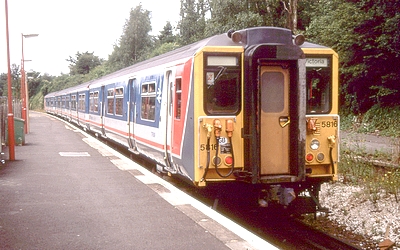
Cl 455 816
pulls into Banstead with an Epsom Downs to London
Victoria service in July 1988
|
|
| |
| The Cl 455/8 EMU,
sporting flashy NSE livery, thus became the most
frequently used type of motive power within months of
NSE's existence - and would reign supreme on the Epsom
Downs branch for years to come. At long last, the branch could
again be seen as being part of the railway's future
rather than just a motley collection of its past. Critics
argued that there wasn't much more to it than a few pints
of paint, but bearing in mind the past thirty-odd years
of the branch, just that alone was more than any other
managing body had previously cared to spend on the line.
The stations looked bright once again and the general
atmosphere was clearly changing for the better.
|
| |
A STATION VANISHES
However,
applying the NSE concept of modernisation to the Epsom
Downs Branch also brought about the most drastic possible
change at the end of the line: the demolition of the
original terminus station at Epsom Downs.
Whilst
the Epsom Downs branch had been reduced to single track
since October 1982, the station layout at its terminus -
albeit reduced to one island platform and two platform
sidings in use - nevertheless still reflected the
spacious construction designed and built to handle the
race traffic generated by the Derby. It had always been
completely oversized for much of the rest of any given
year, but by the mid-1980s race traffic had become
virtually non-existant as rail passengers were much
better served by travelling to Tattenham Corner.
|
| |
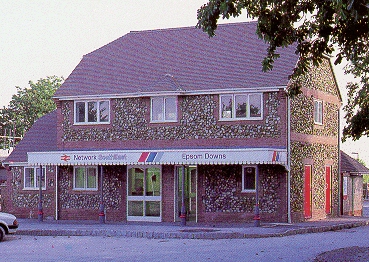
The new
Epsom Downs Station in 1989
|
|
On
Monday, February 13th
1989, a new Epsom Downs platform with provisional
infrastructure - set some 300 yards away from the
original terminating point of the line - opened
late in the evening, replacing the old platform
and station building. Only a few days later - on February 15th
and 16th - the old terminus and
platforms were pulled down in a par force
demolition operation.
The land formerly occupied by the
station and its platforms had previously been
sold off by NSE for redevelopment, and a new
housing estate quickly took shape and replaced
the spacious serenity of the former station
concourse.
The
transformation this brought about was indeed
unbelievable at first sight. as the newly erected
station building even resembled the newly built
houses in its neighbourhood; it was formally
opened on September 22nd 1989 by TV
personality Leslie Crowther [1].
|
|
| |
| With now just one
platform and a single line of track, virtually nothing
remained of what once was Epsom Downs station - indeed,
only the pillars supporting the valanced canopy were
rescued from the old building and put to decorative use. In
later years, the station building would also come to be
home to a children's nursery, aptly named The Railway
Children Kindergarten. |
| |
|
The
reasons for building the terminus - horse racing
traffic - had not been of importance to the
branch for some decades, but now all traces of
its past were completely eradicated. But then again, the story of the Epsom
Downs branch came full circle once more - the
building of housing estates since the 1920s
around the line had produced the commuters the
line needed to flourish, and now the building of
a housing estate meant that the vast amount of
land which Epsom Downs station occupied would be
needed...
From a rational point of view, all NSE
had done was to adjust the terminus to its actual
amount of traffic. Being able to sell almost all
of the old station estate to housing developers
not only meant cash for the rail operator, but
also got rid of a terminus which was completely
overblown for the traffic it saw and therefore
had largely fallen into a state of neglect. The
required maintenance costs were slashed too.
Commuters, of course, were also more
than happy to trade in an increasingly ghostly
and untidy spot for a new and bright station.
|
|
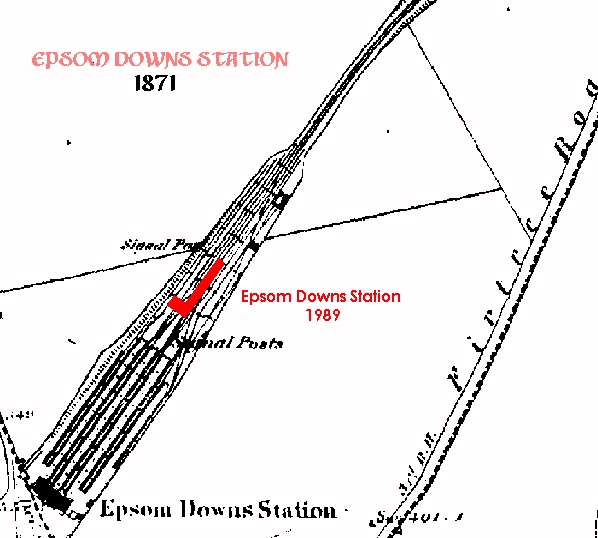
An 1871
survey map of the original station layout at
Epsom Downs, and the approximate position of the
new station building and platform built in 1989
|
|
| |
| By reducing the
station facilities at Epsom Downs to a bare minimum (and,
in effect, all that was really needed), turning the
branch into a modern "single line commuter shuttle
system" was virtually completed. Usage of the
station immediately went up, and has indeed continued to
do so ever since. |
| |

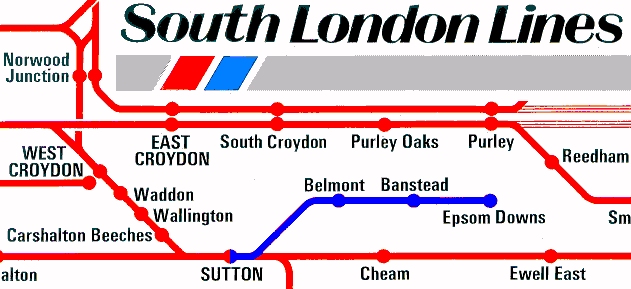

|
| |
|
| |
Continue to "Privatisation"
(1994-1996)
|
| |
|
| |
NOTES
[1] NSE Railway Society
(archived)
BIBLIOGRAPHY
KIRKBY
J.R.W. Kirkby (1983) The Banstead and Epsom Downs
Railway, Locomotion Papers Series, Oakwood Press
LAWRENCE Mark
(1994) Network SouthEast - From Sectorisation to
Privatisation, Oxford Publishing
|
| |
|





